Key takeaways:
- Recognizing anomalous activities is crucial for identifying potential issues and threats within systems.
- Effective monitoring tools, including machine learning algorithms, enhance the ability to detect unusual patterns and streamline response efforts.
- Customizing alert thresholds and regularly reviewing them ensures timely detection and relevance in changing operational dynamics.
- Documenting responses to anomalies helps build a culture of learning and continuous improvement within organizations.
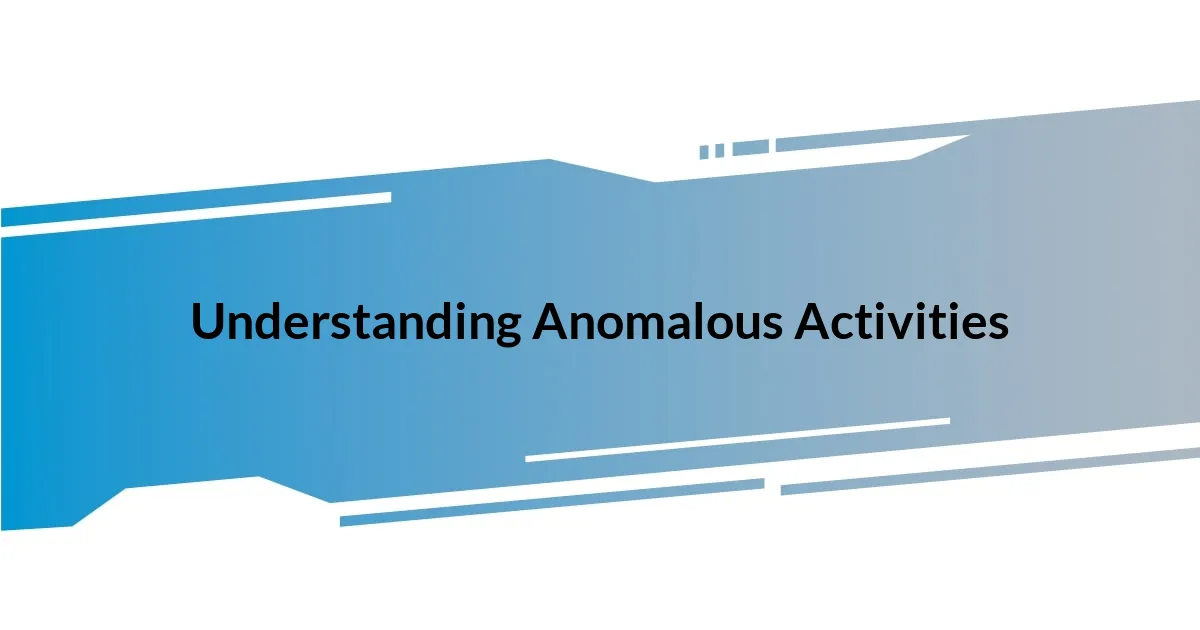
Understanding Anomalous Activities
Anomalous activities refer to behaviors or events that deviate from the expected norm. I remember when I first experienced a major system glitch while monitoring network usage; it was baffling. It prompted me to question how much we really understand about what constitutes ‘normal.’ Recognizing these anomalies is crucial, as they can often signify underlying issues or potential threats.
While analyzing daily patterns, I found that even minor deviations could indicate significant changes. For instance, one evening, I noticed an unusual spike in data access after hours that led me to uncover unauthorized usage. It made me realize how vital it is to stay vigilant and curious about seemingly trivial changes. Have you ever noticed something off in your routine but brushed it aside? Those moments may very well hold the keys to understanding larger issues.
Understanding anomalous activities involves not just identification but also context. I recall a time when a sudden drop in website traffic seemed alarming at first. After some digging, I discovered it coincided with a major news event that diverted attention elsewhere. This experience taught me that anomalies should always be viewed through a broader lens, reminding us that context matters significantly in interpreting data.
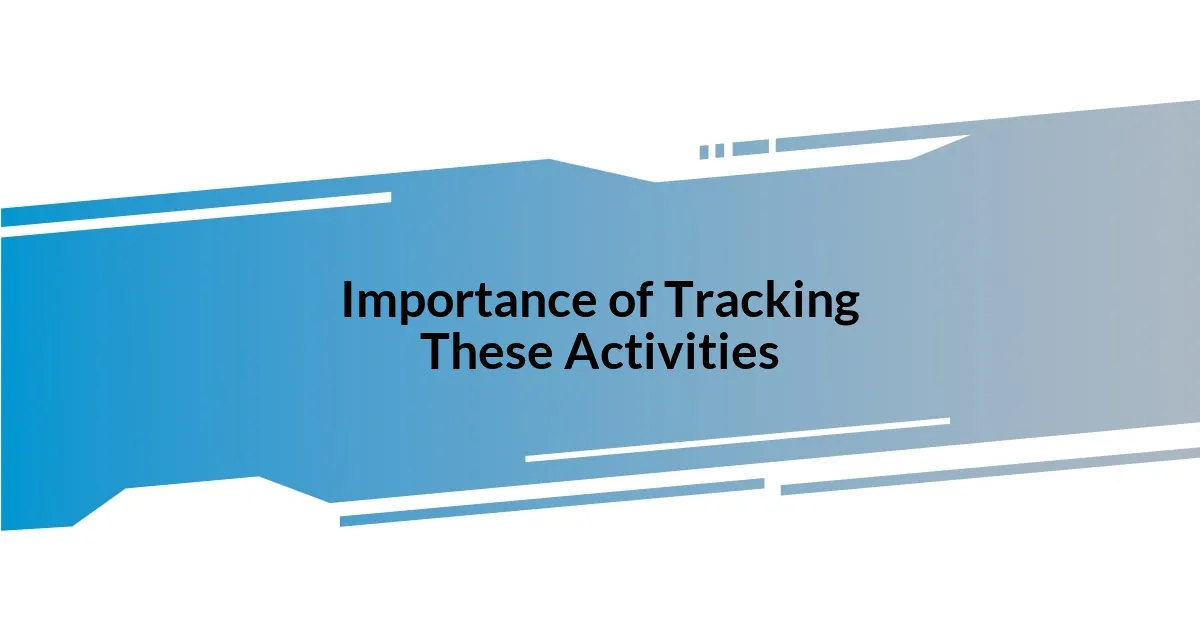
Importance of Tracking These Activities
Tracking anomalous activities is essential for maintaining the integrity of systems and ensuring operational effectiveness. I recall an instance where I discovered unexpected login attempts on our server. Initially, it seemed minor, but it escalated into a full-blown security breach. That experience underscored just how important it is to remain alert to irregular activities, as they can serve as early warning signals for serious problems.
Here are some key reasons why monitoring these anomalies is crucial:
- Early Detection: Identifying unusual patterns allows for prompt response, minimizing potential damage.
- Resource Optimization: Understanding spikes or drops in usage helps in reallocating resources effectively.
- Threat Mitigation: Anomalies often indicate security threats, making tracking vital for safeguarding sensitive information.
- Enhanced Insight: Regular monitoring fosters a deeper understanding of system behavior, aiding in better decision-making.
- Continuous Improvement: Recognizing anomalies can lead to improved processes and protocols, creating a more resilient organization.
Engaging with these activities can transform how we perceive our systems and protect our data, as I’ve learned through firsthand experiences.
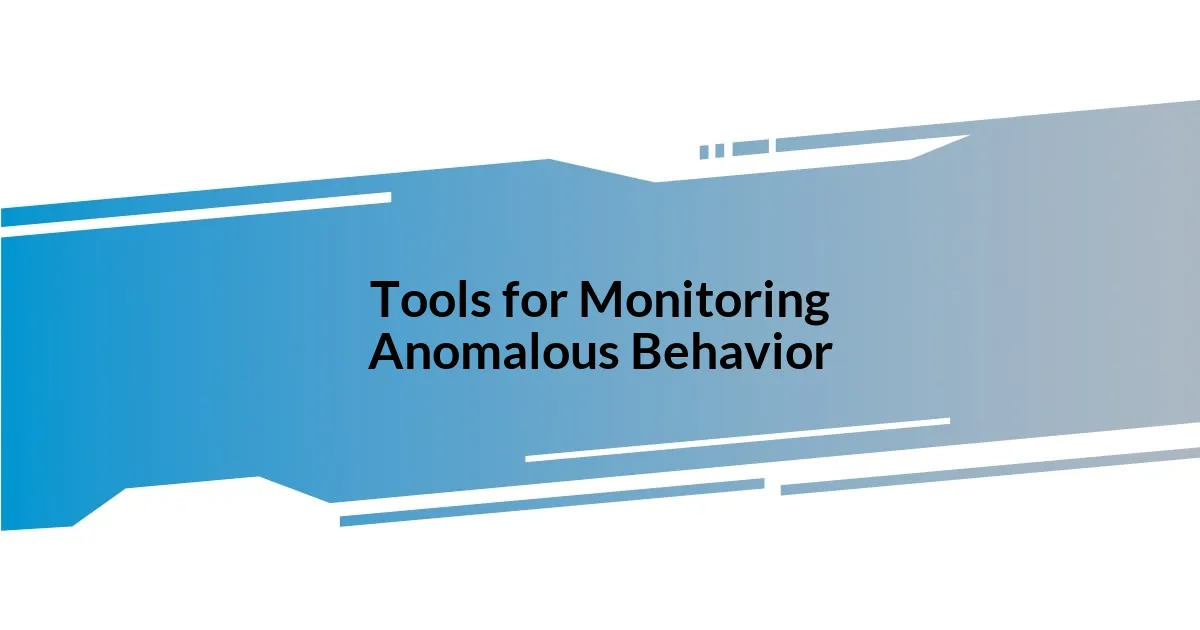
Tools for Monitoring Anomalous Behavior
Tracking anomalous behavior requires the right tools to identify and respond effectively. In my experience, using a combination of software solutions can significantly enhance your ability to monitor unusual activities. For instance, I’ve found that incorporating machine learning algorithms can help in recognizing patterns that humans might overlook, especially when dealing with large datasets. It’s like having a tireless assistant that spots discrepancies faster than I could ever hope to.
Another important factor to consider is integration. A tool that easily connects with existing systems can save valuable time and effort. I remember implementing a monitoring tool that seamlessly synchronized with our security protocols. The ease of access to relevant data not only improved my workflow but also played a crucial role in swiftly addressing potential threats. Knowing that I could rely on my tools helped me feel more confident in decision-making.
When selecting a monitoring tool, it’s also essential to think about usability. No one wants to spend ages learning how to use a complex interface while anomalies go unchecked. I’ve had my fair share of frustrating moments with overly complicated dashboards that made it difficult to isolate problems. Simple, intuitive interfaces can make a world of difference, allowing users to focus on what really matters—keeping our systems secure and operational.
| Tool | Key Features |
|---|---|
| Splunk | Real-time monitoring, machine learning capabilities |
| ELK Stack | Open-source, customizable, powerful search functionalities |
| Prometheus | Time-series data collection, alerting capabilities |
| Sentry | Error tracking, performance monitoring, easy integration |
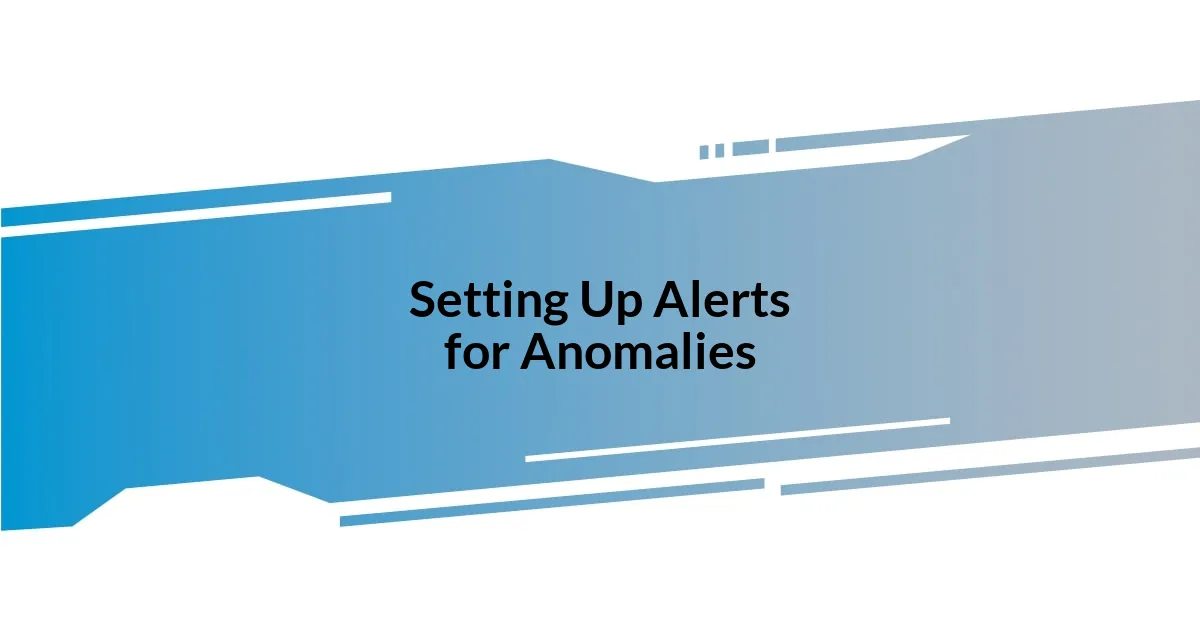
Setting Up Alerts for Anomalies
Setting up alerts for anomalies can feel like creating a safety net for your systems. I remember the day I configured my first alert system. I was anxious—what if it was too sensitive and triggered notifications at every little hiccup? But when it finally caught that unusual spike in data traffic, I felt an immense sense of relief. That alert may very well have saved us from a costly oversight.
When you’re setting up alerts, I recommend customizing thresholds based on the unique behavior of your system. This specificity helps in reducing false positives. I encountered this firsthand while monitoring a web application that saw a surge in signups one holiday season. Initially, the alerts flagged this as unusual activity, but adjusting the parameters afterward allowed me to fine-tune the system and differentiate between genuine anomalies and seasonal surges.
Don’t forget the importance of reviewing your alerting strategy regularly. Systems evolve, and so should your alerts. There was a time when I became complacent, trusting my initial setup without a second thought. That’s when I realized we were missing out on crucial insights because our parameters hadn’t been updated. Have you ever felt that sinking feeling when you missed an opportunity due to outdated information? Regularly reviewing and refining alerts ensures that you’re always on the pulse of what matters most to your operations.
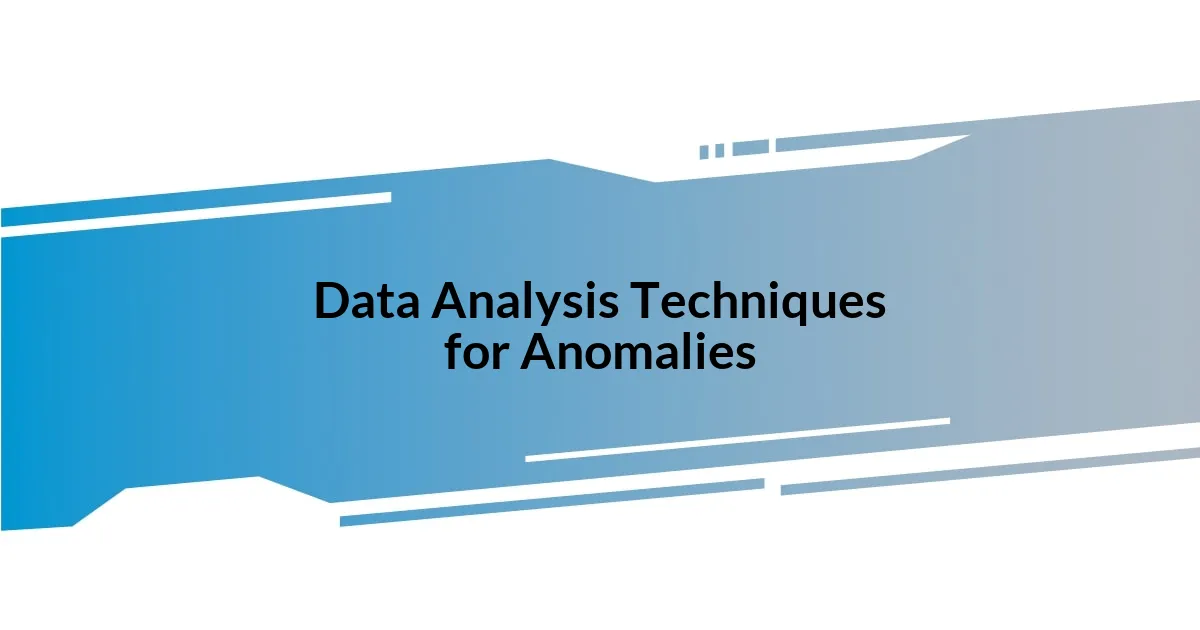
Data Analysis Techniques for Anomalies
Analyzing data for anomalies often requires a multi-faceted approach, and I’ve found that descriptive statistics lay the groundwork. For instance, generating summary statistics such as mean, median, and standard deviation can help me understand the typical behavior of the dataset. I remember a project where I used these metrics to reveal unexpected shifts, leading to the discovery of a data integrity issue that could have gone unnoticed.
Diving deeper, I often rely on visualizations like scatter plots or box plots to spot those pesky outliers that might signal anomalies. There was a time I created a box plot to visualize user activity over several months, and it was like zooming in on a hidden treasure map. What became glaringly obvious were those outlier points—people engaging in suspicious login attempts. These visuals not only made it easier for me to explain the situation to my team but also acted as catalysts for implementing preventive measures.
Another technique I frequently employ is clustering analysis. It’s fascinating how grouping similar data points can illuminate unusual behaviors. I had an instance where clustering helped me identify a segment of users who were accessing our system during odd hours, something we hadn’t considered before. This discovery led us to rethink our security measures, preventing potential breaches before they could escalate. Have you ever noticed how just a shift in perspective can completely change your understanding of the situation?
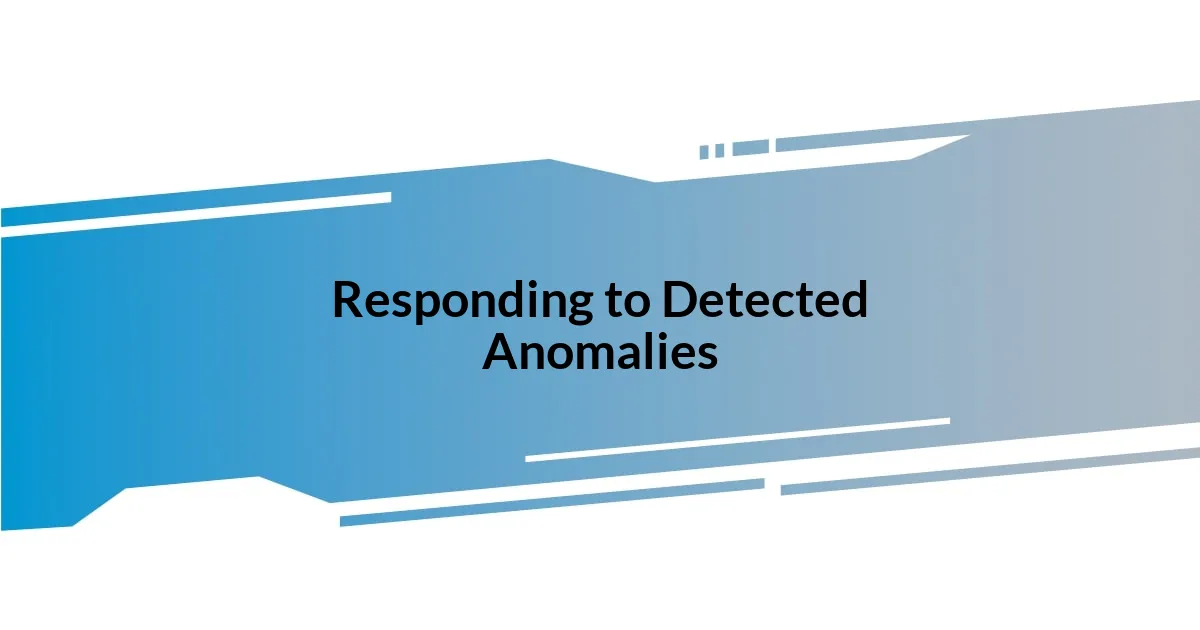
Responding to Detected Anomalies
Once an anomaly is detected, my first instinct is to dive in and analyze it thoroughly. I recall a moment when I spotted unusual login times that didn’t align with user patterns. The urgency I felt to investigate was palpable — I knew that swift and decisive action could be the difference between a minor glitch and a major security breach. This experience taught me the value of a rapid response plan; it helps focus efforts so you don’t get lost in the noise of data.
Understanding the scale and impact of the anomaly is crucial. For instance, I encountered a significant data upload that seemed harmless at first glance. However, upon further investigation, it unfolded into a larger issue involving unauthorized data access. I remember the butterflies in my stomach—the realization that what I thought was a simple case of excess traffic was actually a potential breach made me appreciate the importance of context. Questions like, “Is this a rare event or part of a larger trend?” can reshape how we handle these detections.
Once you’ve acted on an anomaly, documenting your response becomes pivotal. I’ve learned that the insights gained from each incident serve as building blocks for future actions. After resolving an unexpected spike in API calls, I made it a point to detail what caused it and how we responded. Reflecting on these events can spark ideas for refining systems and processes — has there ever been a moment in your own work where hindsight completely reshaped your approach? Creating a culture of learning from anomalies fosters resilience, turning challenges into growth opportunities.
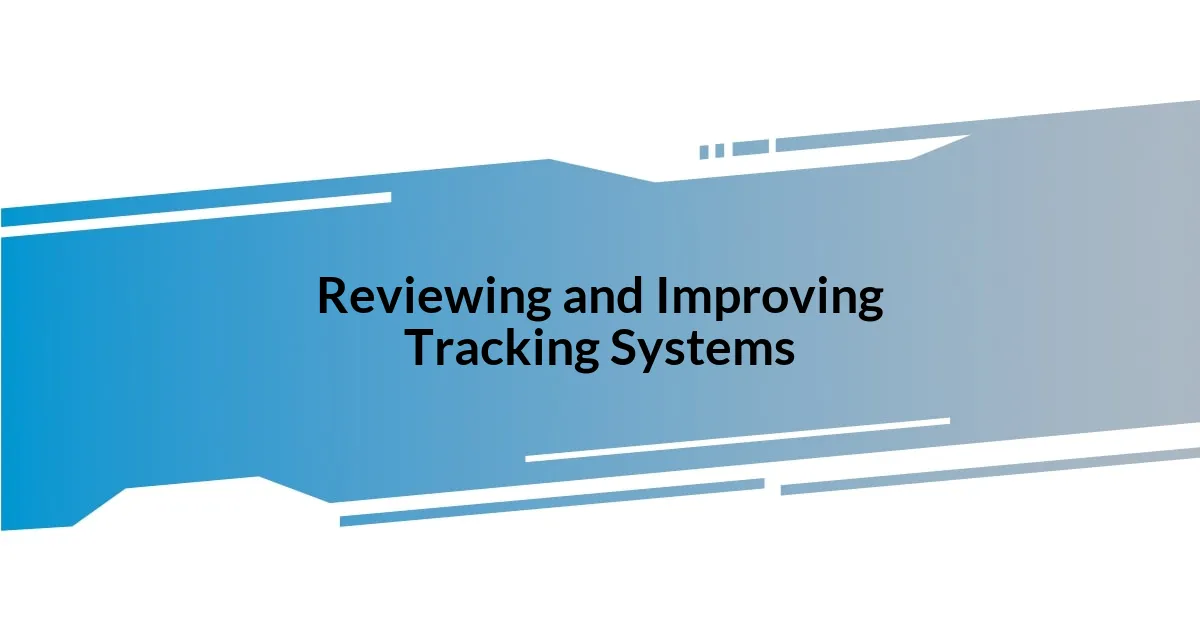
Reviewing and Improving Tracking Systems
Reviewing and improving tracking systems is something I believe is essential for maintaining their effectiveness. I often begin this process by revisiting the metrics we’ve gathered over time. For instance, after implementing a new tracking tool, I realized that we were missing critical data points. It was a bit frustrating at first, but tweaking our existing setup revealed so many hidden gems of information that ultimately enhanced our tracking capabilities.
I find that actively seeking feedback from team members who’ve directly engaged with the tracking system provides a wealth of insights. On one occasion, a colleague mentioned how difficult it was to navigate through the data reports, and I took that feedback to heart. By collaborating, we redesigned our reporting structure, making it not just user-friendly but also more aligned with our objectives. Have you ever had that moment when an unexpected conversation unlocked a new path for improvement? I sure have, and it can be such an enlightening experience.
Another key aspect is regular system audits, which I’m a strong proponent of. I vividly recall a scheduled audit that unveiled inconsistencies between our data inputs and outputs. It was alarming to see data discrepancies surfacing, but addressing them promptly led us to refine our tracking algorithms significantly. That experience reinforced my belief that continuous improvement isn’t just a goal; it’s a mindset. Trust me, making this practice a routine part of your operation can empower your team and enhance the reliability of your tracking systems.